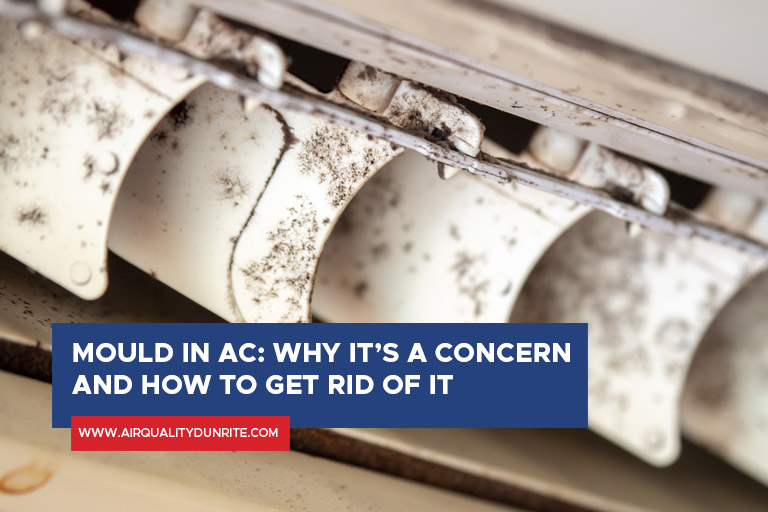When the weather calls for air conditioning, there is nothing worse than discovering a mouldy air conditioner after the winter season.
Air conditioners recycle the air in the room to make it feel refreshing and cool. However, a mouldy AC can spew microscopic mould spores and bacteria into the air, exposing you and your family to a raft of potentially serious health problems.
But how does mould enter the air conditioner? What are the ways to prevent its return?
Let’s get down to business!
How Does Mould Get Inside Your Air Conditioner?
Mould in air conditioners is a common problem that many homeowners face. It can cause health issues such as allergies, respiratory problems, and headaches. The question is, what causes mould in air conditioners in the first place?
- Moisture
One of the primary reasons why mould grows in air conditioners is moisture. Air conditioners remove humidity from the air, but they can also create condensation inside the unit. If the moisture is not drained or cleaned properly, it can lead to mould growth.
- No Regular Maintenance
Another reason for mould growth in air conditioners is a lack of regular maintenance. When air filters, coils, and ducts are not cleaned or replaced, they can accumulate dust and debris, creating an environment for mould to grow.
- Oversized Unit
If the air conditioner is oversized for the space it is cooling, it may not run long enough to remove the humidity from the air. This can create a perfect environment for mould to thrive.
To prevent mould growth in your air conditioner, it’s important to schedule regular maintenance and cleaning. It is also crucial to ensure proper drainage of the moisture that the unit creates. By taking these steps, you can prevent the growth of mould and ensure that your air conditioner is working efficiently and effectively.
Can Mould in AC Make You Sick?

You are probably wondering, “is mould in your air conditioner dangerous?” Yes, it can be.
Mould is a type of fungus that can grow in various areas of your home, including your air conditioning unit. The presence of mould in your AC can not only be harmful to the unit but also to your health.
Mould in AC can release spores that can circulate in the air and be inhaled by household members, leading to various health effects. The health effects of mould in air conditioners include:
- Watery eyes
- Runny nose
- Coughing
- Sneezing
- Itching
- Difficulty breathing
- Wheezing
- Asthma
- Headache
- Fatigue
The best way to determine if there is mould in your air conditioner is to have a professional perform mould air quality testing. If mould is present, it is essential to have regular AC inspections and maintenance to address the issue promptly.
Signs of Mould Growth in Air Conditioners
Air conditioners are designed to provide comfortable indoor environments by controlling temperature, humidity, and air quality. However, they can also be a breeding ground for mould growth if not properly maintained. Therefore, it is essential to identify the signs of mould in air conditioners to prevent its spread.
- Visible mould growth on the air conditioner’s vents or filters.
- Musty or mouldy odour coming from the air conditioner.
- Excessive humidity levels in the indoor space.
- Water droplets or moisture around the air conditioning unit.
- Unexplained respiratory symptoms such as coughing, sneezing and wheezing.
- Unusual rust or corrosion on the air conditioning unit.
- Discoloration or stains on walls or ceilings near the air conditioner.
- Increased energy bills due to decreased efficiency of the air conditioning unit.
- Reduced cooling performance of the air conditioner.
How to Get Rid of Mould in Air Conditioners

The process of cleaning mould from air conditioners is quite simple, but it depends on the type of AC system you have. For instance, getting rid of mould in the window air conditioner is easy, but the mould removal process in the central air conditioner requires more effort.
However, you have different options when dealing with AC mould infestation.
- DIY AC Mould Removal
If you have a small, removable window-type AC with insignificant mould damage, you might choose to clean the mould by yourself. However, DIY AC mould cleaning is not recommended by most HVAC experts because of the possibility of spreading the mould to other areas of your home.
- Replace Old, Mouldy AC Unit
If your unit develops significant mould, replacing it would be much less expensive than removing the mould. This is especially true for freestanding or window units that are smaller and less expensive. However, when mould has completely engulfed your AC system, you might miss some spots when cleaning it. which may result in mould regrowth after removal.
- Hire an Expert HVAC Technician
For most people, disposing of a functional but mouldy AC is not an easy decision. If mould growth is not extensive, it may not also be the best solution. The best course of action is to hire an HVAC expert. A professional HVAC cleaning process can completely eradicate mould in AC and repair the damage by replacing the component. Hiring an expert is your best shot, especially if you have a central air conditioning system. Contact a professional HVAC technician for an inspection or air conditioner repair in Toronto.
How to Prevent Mold Regrowth in Your Air Conditioner?
There is no surefire way to stop mould from regrowing in your air conditioner, but there are things you can do to make it less likely that you will have the problem.
- Change your AC filter on a regular basis—either every 30 or 90 days or as directed.
- Choose an air filter made specifically for mould control. Use the ones with higher MERV ratings. High-quality AC filters can effectively eliminate organic debris (serves as food for mould colonies) from the air.
- Add a UV light air purification system to your existing HVAC system to eliminate mould spores and improve the overall air quality.
- To reduce condensation within air ducts, be sure to seal and insulate them.
- Drain drip pans and wash them with bleach regularly to get rid of mould colonies.
- If you live in an area with high moisture levels, use a dehumidifier to remove excess humidity in your home.
- Professionals can inspect your HVAC system on an annual basis to look for mould in the air conditioner unit or other parts.
- When you are on vacation, do not turn off your air conditioner—especially in hot, humid weather—because mould tends to grow in units that are not being used. Only air movement is required, you can set your air conditioner to a higher temperature. Using a smart AC controller to control your unit remotely is the best option in this case.
For growth, mould spores require nutrients, temperature, and moisture. It is time to act if you smell a musty odour or see mouldy signs on the surface. Call Air Quality Dunrite now at (416) 342-1939 for air conditioner maintenance, installation, or repair services.



